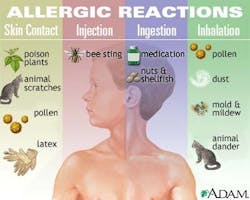Anaphylaxis: What you need to know about life or death allergic reactions
What is anaphylaxis?
Anaphylaxis is a serious allergic response that often involves swelling, hives, lowered blood pressure and in severe cases, shock and death. Anaphylaxis requires immediate medical treatment, including a prompt injection of epinephrine and a trip to a hospital emergency room. If anaphylactic shock isn't treated immediately, it can be fatal.
Isn’t this a FD/Paramedic issue?
Ideally, yes. However, if you are on patrol you may be the closest to respond to the 911 call. Anaphylaxis is a severe and sudden allergic reaction. It occurs within minutes of exposure to an allergen. If not treated appropriately, anaphylaxis can turn deadly very quickly. Anaphylactic shock can also occur while a suspect is in your custody both in or outside of a detention facility.
Additionally, failure to recognize anaphylaxis and to seek prompt, appropriate treatment tends to upset everyone who has more stripes or stars than you do, elected officials, and family members as well. This is truly an ounce of prevention and quick action scenario.
What are the symptoms of an anaphylactic reaction?
The major difference between anaphylaxis and other allergic reactions is that anaphylaxis typically involves more than one system of the body.
- Red rash (usually itchy and may have welts/hives)
- Swollen throat or swollen areas of the body
- Wheezing
- Loss of consciousness
- Chest tightness
- Trouble breathing
- Hoarse voice
- Trouble swallowing
- Vomiting
- Diarrhea
- Stomach cramping
- Pale or red color to the face and body
It is important to remember that, like other allergic reactions, an anaphylactic reaction does not usually occur after the first exposure to an allergen but after a subsequent exposure. You may have an allergic reaction to a bee sting, but the next sting could lead to anaphylaxis.
What causes anaphylaxis?
Food allergens are the most common cause of anaphylaxis. An estimated 15 million people have food allergies; 9 million adults and 6 million children have food allergies in the United States. Young children are the most affected. Emergency department visits for food-induced acute reactions occur about every 3 minutes; and visits for food-induced anaphylaxis occur every 6 minutes. According to the CDC these rates are increasing. Approximately 20-25% of epinephrine administrations in schools involve individuals whose allergy was unknown at the time of the reaction. The main culprits for food allergies are cow’s milk, eggs, fish, shellfish, peanuts, tree nuts, soy and wheat.
Stinging insects are another common cause of anaphylaxis. It is estimated that potentially life-threatening systemic reactions to insect stings occur in up to 1% of children and 3% of adults. Hymenoptera is the name for the order of stinging insects that cause allergies, which include five species: honeybees, yellow jackets, paper wasps, hornets and fire ants. Hymenoptera stings account for more deaths in the United States than any other venomous animals, accounting for at least 40 deaths annually.
Certain medications can also cause an anaphylactic reaction; these include antibiotics (amoxicillin, ampicillin, penicillin, tetracycline), aspirin and other over-the-counter pain relievers (ibuprofen and naproxen), sulfa drugs, chemotherapy drugs and the intravenous (IV) contrast used in some imaging tests. Make sure if you have allergies to any medications that it is noted on your medical records, including the symptoms of the reaction you have. Wear a medical alert bracelet as well.
Latex can also cause allergic reactions that range from mild to deadly. Latex is found in many forms, not just gloves, but that is where you and the medical community will most likely have contact with natural rubber products. Latex can be found in tennis shoes, balloons, condoms, tires, chewing gum, and the scratch-off portion of the instant lottery ticket.
What is the protocol if you arrive on the scene of someone in anaphylactic shock?
- Intramuscular (IM) epinephrine is the first-line treatment in all cases of anaphylaxis. Because anaphylaxis symptoms may progress rapidly and become life threatening, it is important that treatment with epinephrine be initiated promptly. Ascertain if the subject or a companion or a family member has an immediate access to an EpiPen. EpiPens are spring loaded autoinjectors designed to deliver a specific dose of an epinephrine base on a patient’s weight. If they do, or have, assist them or administer epinephrine into the muscle in the upper, outer thigh.
- Call for additional help AFTER delivering epinephrine.
- Eliminate additional allergen exposure. Remove food from the mouth and teeth. If the allergic reaction is from a bee sting, scrape the stinger off the skin with something firm (such as a fingernail or plastic credit card). Do not use tweezers. Squeezing the stinger will release more venom.
- Check the person's airway, breathing, and circulation. A warning sign of dangerous throat swelling is a hoarse or whispered voice. If necessary, begin rescue breathing and CPR. Do not place a pillow under the person's head if they are having trouble breathing; this can block the airways. Do not give the subject anything by mouth if the person is having difficulty breathing; this can lead to choking and asphyxia.
- Take steps to prevent shock. Have the person lie flat, raise the person's feet about 12 inches (30 centimeters), and cover the person with a coat or blanket. Do not place the person in this position if a head, neck, back, or leg injury is suspected, or if it causes discomfort.
- Do not assume that any allergy shots the person has already received will provide complete protection. A second dose of epinephrine may be required in up to 20% of cases of anaphylaxis
- Paramedics or other EMS providers may place a tube through the nose or mouth into the airways. An emergency tracheotomy may be required
- The subject will require emergency follow-up at the nearest hospital ER.
- Try to calm and reassure the person and any companions.
- After the medical crisis is over the subject will be referred to an allergist/immunologist for an accurate diagnosis and appropriate prescriptions.
How does epinephrine work during an anaphylactic reaction?
No other medicine acts on so many body systems as epinephrine, which is why it is the drug of choice for anaphylaxis.
- It causes constriction, or tightening, of the blood vessels, which decreases swelling and also helps to increase blood pressure.
- It increases the heart’s contraction and heart rate, which can help to prevent or reverse cardiovascular collapse.
- It relaxes the muscles around the airways in the lungs, helping the airways to open up.
- It prevents the release of additional allergic chemicals, which aids in stopping further progression of the reaction.
Note: A severe allergic reaction may sometimes last hours. Epinephrine works quickly but may only last for 15 to 20 minutes. If a patient responds poorly to the initial dose or has ongoing or progressive symptoms a second dose may be required after 5 to 15 minutes.
I’m a K-9 handler: Can my dog have an anaphylactic reaction?
The most common symptoms of anaphylaxis in dogs include the sudden onset of diarrhea, vomiting, shock, seizures, coma, and death. The animal's gums will be very pale, and the limbs will feel cold. If you know that your dog has had a history of allergies (often insect stings) an EpiPen or syringe of epinephrine should always be kept with you. Dogs weighing over 45 lbs. can use the standard 0.3 mg epinephrine EpiPen (adult’s dose) or 0.15mg (child’s dose) for dogs weighing less. The dog often requires close hospital monitoring for 24 to 48 hours after the reaction and may require life support.
Should law enforcement officers be allowed to carry epinephrine auto-injectors?
Illinois thinks so. As of Sunday, January 1, 2017 the Annie LeGere law (Bill HB 4462) went into effect in that state, and will likely save lives as first responders will have access and training to administer epinephrine. Will other states follow suit? Questions about the costs of training and EpiPens themselves (at about $600 for a 2-pack), as well as liability will obviously be issues that will need to be explored.
Can I be an officer if I have a history of severe anaphylactic reactions?
Of course; you know better than anyone how to prevent reactions, and how to treat them. However, make sure you let your partners and supervisors know your medical condition. If you are allergic to yellow jackets and are stung while on duty carry an EPI pen on your vest through the Velcro straps, and make sure everyone knows where it is. Carry your back-up as well in case a second dose is needed.
Are all state laws related to access to epinephrine at schools, camps, restaurants, etc. the same?
No, not even close. I strongly suggest you review these two websites related to the epinephrine stocking and school access laws in your state.
- Epinephrine Entity Stocking Laws in the U.S. (https://www.networkforphl.org/_asset/8483ms/Issue-Brief-Epi-Entity-Stocking.pdf)
- School Access to Epinephrine Map (https://www.foodallergy.org/advocacy/epinephrine/map)
Are there any tips to prevent allergic reactions and anaphylaxis?
- Avoid triggers such as foods and medicines that have caused an allergic reaction in the past.
- Ask detailed questions about ingredients when you are eating away from home. Asian restaurants and bakeries who use nuts are of concern.
- Notify hosts/hostesses of allergies. If in doubt, bring your own food.
- Carefully examine ingredient labels.
- If you have a child who is allergic to certain foods, introduce one new food at a time in small amounts so you can recognize an allergic reaction.
- Individuals who know that they have had serious allergic reactions should wear a medical ID tag.
- Make sure all medical providers and pharmacies are aware of your allergies.
- If you have a history of serious allergic reactions, carry emergency medicines (such as a chewable antihistamine and injectable epinephrine or a bee sting kit) according to your provider's instructions.
- Check the expiration date of all emergency medications and be sure to refill your prescription before it expires
- Do not use your injectable epinephrine on anyone else. They may have a condition (such as a heart problem) that could be worsened by this drug.
- If you're allergic to insect stings, wear protective clothing when you go outside. Avoid shiny fabrics or jewelry, which can attract insects. Put a lid over sugary drinks.
- See a specialist for an accurate diagnosis and to obtain appropriate prescriptions.
About the Author

Pamela Kulbarsh
Pamela Kulbarsh, RN, BSW has been a psychiatric nurse for over 25 years. She has worked with law enforcement in crisis intervention for the past ten years. She has worked in patrol with officers and deputies as a member of San Diego's Psychiatric Emergency Response Team (PERT) and at the Pima County Detention Center in Tucson. Pam has been a frequent guest speaker related to psychiatric emergencies and has published articles in both law enforcement and nursing magazines.
